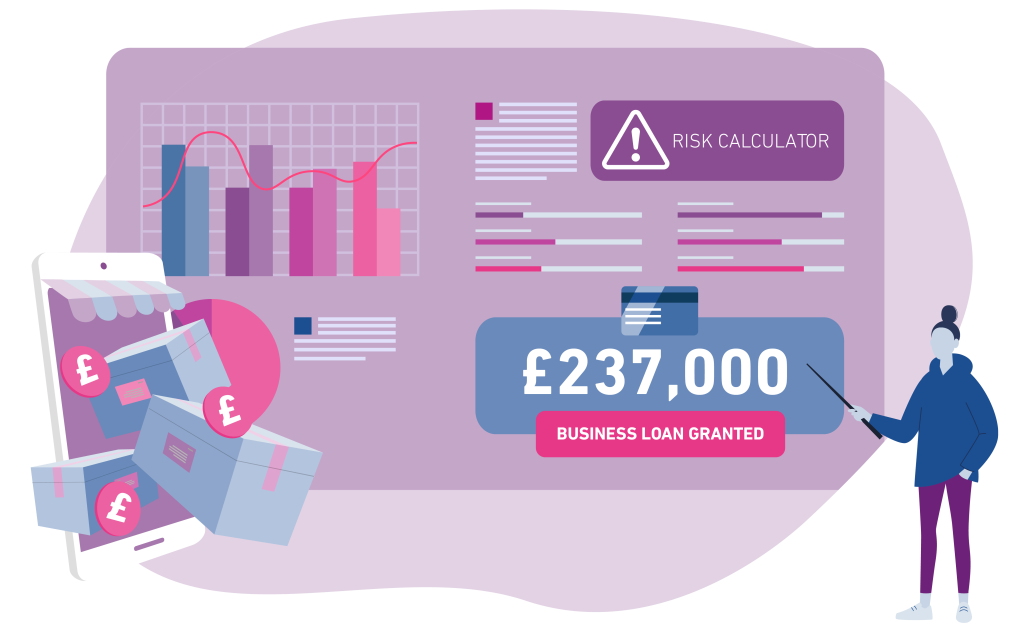Commercial affordabilityUnderstanding financial risk for sustainable business growth and empowering smarter financial decisions
Guide
In the competitive world of business, securing financing is often the fuel that propels growth, however, not all loans are created equally. Understanding commercial affordability – your business’s ability to comfortably repay a loan without jeopardising its financial health – is crucial for business owners looking to secure the right financing and achieve long-term success.

It’s a win-win for both parties: businesses benefit from manageable loan payments that ensure smooth cash flow and continued investment in growth initiatives, and lenders benefit from minimised risk of defaults and a guaranteed return on their investment with interest.
What is commercial affordability?
Commercial affordability is a measure of how effectively a business can manage its financial resources and credit repayments to sustain and grow its operations within its financial constraints, without undue financial pressure.
Commercial affordability is impacted by numerous factors, including:
- Income/turnover
- Cost of inputs such as materials and labour
- Operating expenses
- Profit margins
- Existing debt levels and credit obligations
- Economic conditions
- Government and regulatory policies
- Business model and market position
Understanding commercial affordability assessments
Assessing a business’s ability to repay a loan goes beyond just looking at a single snapshot in time. While lenders analyse historical financial data like profit and loss statements, they acknowledge the inherent challenges of predicting future performance. Unforeseen events like political shifts, economic downturns or natural disasters can significantly impact a business’s trajectory.
Ideally lenders should start by considering four main elements, with an emphasis on the first two:
1. Business income/turnover
2. Costs
a. Variable costs
b. Operating costs
c. Direct costs
d. Fixed costs
3. Depreciation
Reduction in the value of business assets over time
4. Dividends / drawing
Proportion of profits paid to the owners of the business
These are used to calculate the ‘Net Free Cash Flow’, and a percentage of this (say 50%) defines what a businesses’ maximum annual debt repayments should be.
Approaches to business affordability assessments
Getting this information, however – especially up-to date data – is not always straightforward nor possible.
Experienced lenders also understand the importance of going beyond the cold, hard numbers. Instead, using reliable and up-to-date data and applying flexibility to different circumstances will provide the most transparent picture of affordability.
For small and medium-sized businesses, there are three primary approaches for assessing loan affordability:
- Current Account Turnover (CATO) and Commercial Credit Account Information Sharing (CAIS): This method is often used for smaller loans (typically under £100,000) by analysing business bank account data along with credit information sharing platforms. It provides a quick snapshot of a business’s current financial activity.
- Categorised Bank Account Data: Here, lenders leverage advanced technology to categorise your bank account data, creating a pseudo profit and loss report. This provides a more in-depth view of the business’s current financial state, including income streams and expense breakdowns.
- Management Accounts Data: This approach involves analysing the business’s own financial reports, including cash flow forecasts and future projections. This is the most comprehensive method, offering lenders a detailed understanding of the business’s long-term financial health and future expectations. It’s typically used for larger or more complex loan applications.
Responsible loan assessment requires a balancing act. Lenders need accurate information to gauge risk, often obtained through financial documents. However, excessive data collection can burden businesses and create friction in the application process. To achieve the right balance, lenders consider the specific risk of each borrower, the availability of data and the loan size. This allows them to choose the most appropriate assessment methods, ensuring a smooth customer experience while making responsible lending decisions.
Key takeaway
Assessing business loan affordability involves balancing data accuracy and flexibility. Lenders use methods like analysing bank turnover for smaller loans, categorising bank data for a detailed view, and reviewing management accounts for larger loans. They must balance thorough risk assessment with avoiding excessive data collection to ensure a smooth and responsible lending process.
Qualitative assessments of affordability
While a strong financial foundation is essential, securing financing often hinges on more than just numbers. Forward-thinking lenders also consider qualitative factors that paint a more comprehensive picture of your business’s potential and ability to repay a loan. Here are some key qualitative aspects that can strengthen your affordability case:
- Management strength and experience: A seasoned leadership team with a proven track record of success inspires confidence in lenders. They look for evidence of past achievements, strategic thinking, and the ability to navigate challenges. A strong management team fosters stability and increases the likelihood of achieving financial goals, making your business a more attractive loan candidate.
- Business model sustainability: The viability of your business model is a crucial factor for lenders as they want to see a clear path to profitability and sustained growth. This involves evaluating your competitive advantage, target market, pricing strategy, and overall business plan. A well-defined and sustainable business model demonstrates a long-term vision and reduces the risk of future financial difficulties, ultimately strengthening your affordability assessment.
- Industry expertise and market position: Your expertise within your industry and your position within the market significantly impact your attractiveness to lenders. Operating in a niche with a strong competitive advantage positions your business for success. Lenders look for businesses with a clear understanding of their target audience, a differentiated product or service offering, and a solid market share. Demonstrating industry expertise and a strong market position assures lenders of your ability to generate revenue and manage debt effectively.
By focusing on both quantitative and qualitative aspects of your business, you can present a compelling case for business affordability and secure the financing you need to achieve your growth objectives.

Key factors influencing business affordability
Financial health and creditworthiness
To assess your loan eligibility and secure the best terms, lenders look at several factors that paint a picture of your financial health. This includes your creditworthiness, demonstrated by a consistent track record of on-time payments, positive cash flow, and a healthy balance sheet. They’ll also analyse your true income and business costs, ensuring a healthy profit margin so you can comfortably repay the loan while reinvesting in your business.
Existing debt plays a role, with lower debt-to-income ratios being more favourable. Finally, the value and depreciation rate of your business assets can be considered, as assets with slower depreciation offer additional security to lenders.
All of these checks though are becoming more complicated. Soaring inflation, rising interest rates, and a volatile economic landscape make commercial loan affordability assessments a complex challenge. Lenders require a comprehensive view to ensure business resilience. This means leveraging all available data, advanced analytics, and even forward-looking economic forecasts to get a full picture of a borrower’s ability to repay.
Market & industry conditions
While your internal financial health is a crucial factor, lenders also consider the broader economic landscape, specifically market trends and industry conditions, when assessing affordability. These external forces can significantly impact your business’s ability to repay a loan.
Market trends
Businesses operating in markets experiencing significant growth tend to have more optimistic future revenue projections. This translates to a stronger case for affordability in the eyes of lenders. Imagine a company in a booming tech sector; their projected future earnings are likely much higher compared to a business in a stagnant industry. This increased earning potential makes them appear as more affordable borrowers, as they’ll have a larger pool of income to service the loan.
Industry profit margins
The industry you operate in also plays a role. Industries with traditionally high-profit margins, such as software or pharmaceuticals, can typically handle larger loan burdens. This is because they have a bigger buffer between their income and expenses. Conversely, businesses in industries with lower profit margins, like restaurants or retail, have less wiggle room in their budgets. Taking on a large loan can be riskier for these businesses, as even a slight dip in sales could make repayments challenging.
The rising cost of living
The rising costs of living and of business, including raw materials, labour and even overhead expenses like rent and utilities, can significantly impact your affordability. Imagine a bakery facing a spike in flour prices. This increase in operational costs eats away at their profit margin, making it harder to manage existing debt, let alone take on additional loan payments. Lenders are aware of these external pressures and will factor them into their affordability assessments.
Strategies for businesses to improve affordability
Strengthen financial performance
Take a critical look at your financial health and identify areas for improvement. Analyse your expenses to pinpoint areas where you can cut back without sacrificing quality or efficiency. Streamlining operations and reducing unnecessary costs will free up valuable cash flow that can be used to service loan repayments.
Additionally, explore revenue growth strategies. This could involve expanding your customer base by entering new markets, launching innovative products and services, or implementing targeted marketing campaigns to attract new customers.
Build a strong credit history
A positive credit history demonstrates your commitment to responsible financial management and increases your attractiveness to lenders. Make on-time payments for all your existing debts, including loans, vendor invoices, and utilities. This consistent track record builds trust and confidence in your ability to manage debt effectively.
Consider establishing business credit lines through credit cards or lines of credit specifically designed for businesses. Consistent and on-time payments on these lines will build a positive business credit history, separate from your personal credit score, further strengthening your loan application.
Align loan terms with business goals
Don’t settle for the first loan offer that comes your way. Take the time to shop around and explore various financing options from different lenders. There’s a variety of loan structures available, with options for short-term or long-term repayment periods. Carefully consider factors like interest rates, repayment schedules, and any prepayment penalties associated with the loan. Ultimately, the most suitable loan will align with your specific needs and repayment capacity. Don’t be afraid to negotiate terms that support your long-term business goals and ensure your future success.
Key takeaway
Key factors in business affordability include financial health, creditworthiness, and market conditions. Lenders assess your stability through credit history, cash flow, profit margins, and existing debt, while also considering industry trends and economic pressures. To improve affordability, businesses should boost financial performance, build a strong credit history, and align loan terms with their goals. Effective management of expenses and revenue, along with negotiating favourable loan terms, enhances financing opportunities.
How can we help?
Being able to quickly and effectively assess the affordability of loans is a critical issue within the commercial lending market. It helps meet the increasing demands from regulators – especially with respect to responsible lending – and it also improves margins.
Understanding commercial affordability is not just about securing a loan; it’s about laying the foundation for sustainable business growth. It is important to verify data accuracy by checking information held by Credit Reference Agencies (or CRAs) is correct and that current banks, lenders and creditors are reporting accurately on existing business accounts alongside up to date and accurate management accounts.
By maintaining a strong financial foundation, taking steps to improve your affordability metrics, and working collaboratively with lenders, you can secure the resources needed to achieve your business dreams.













